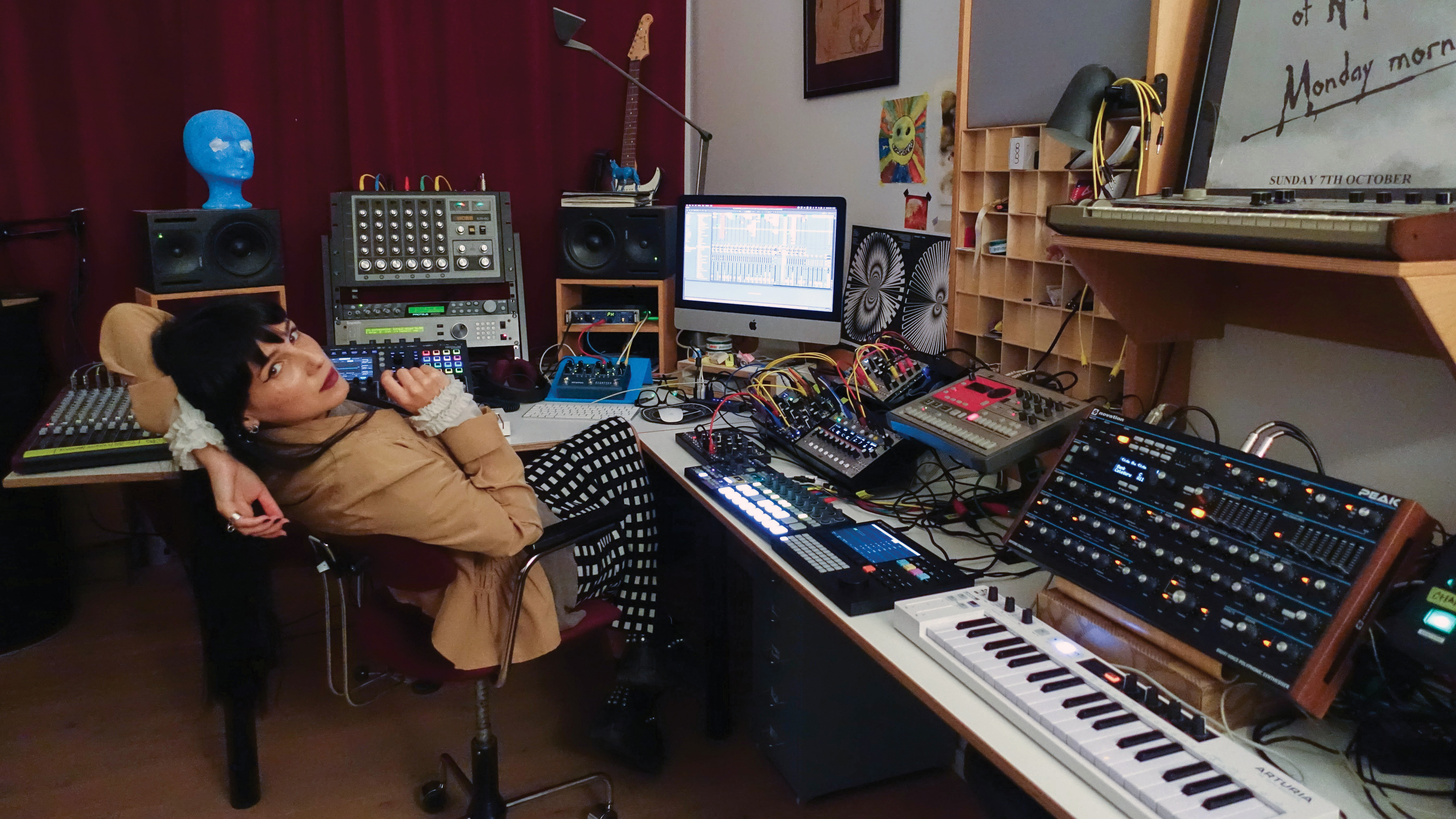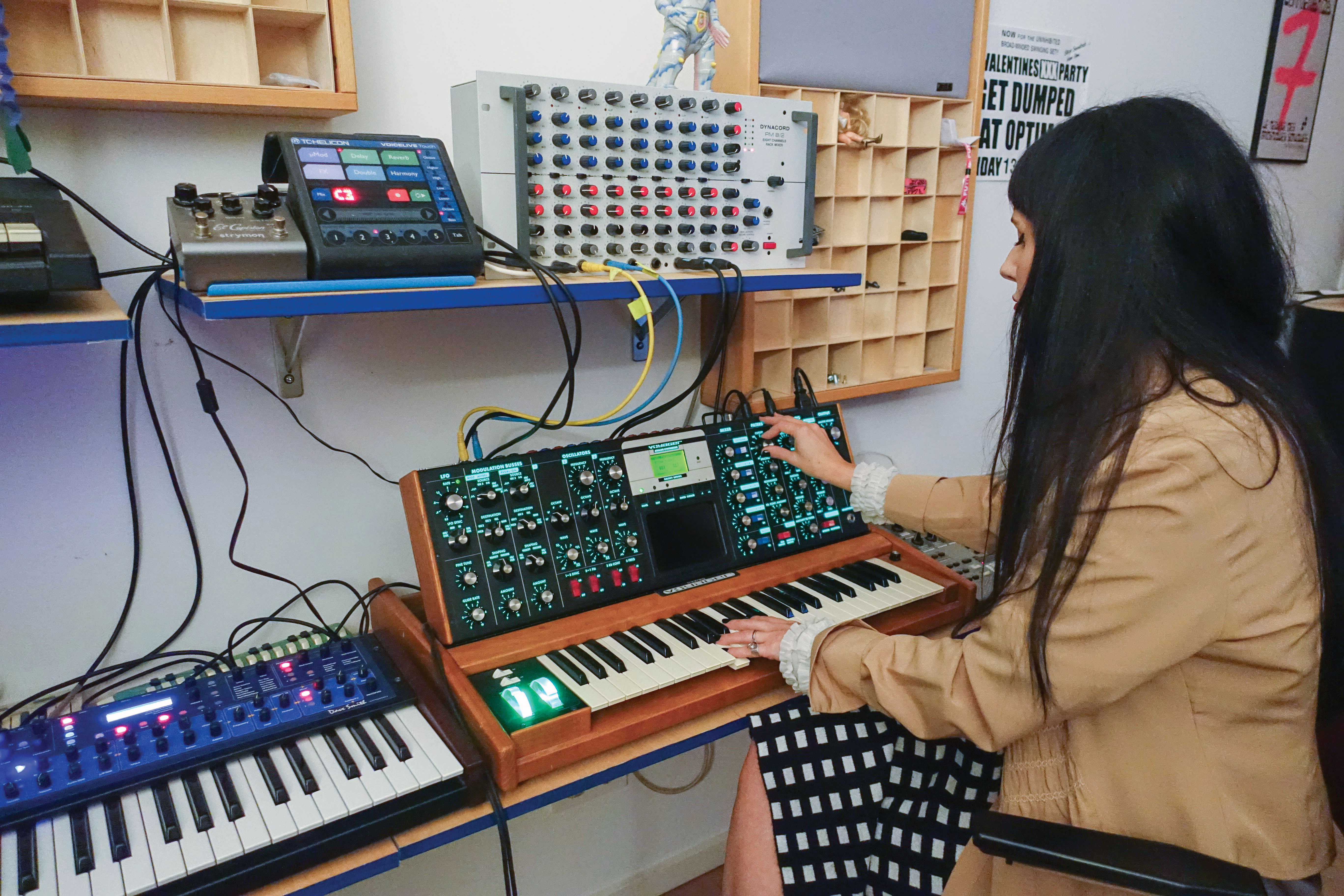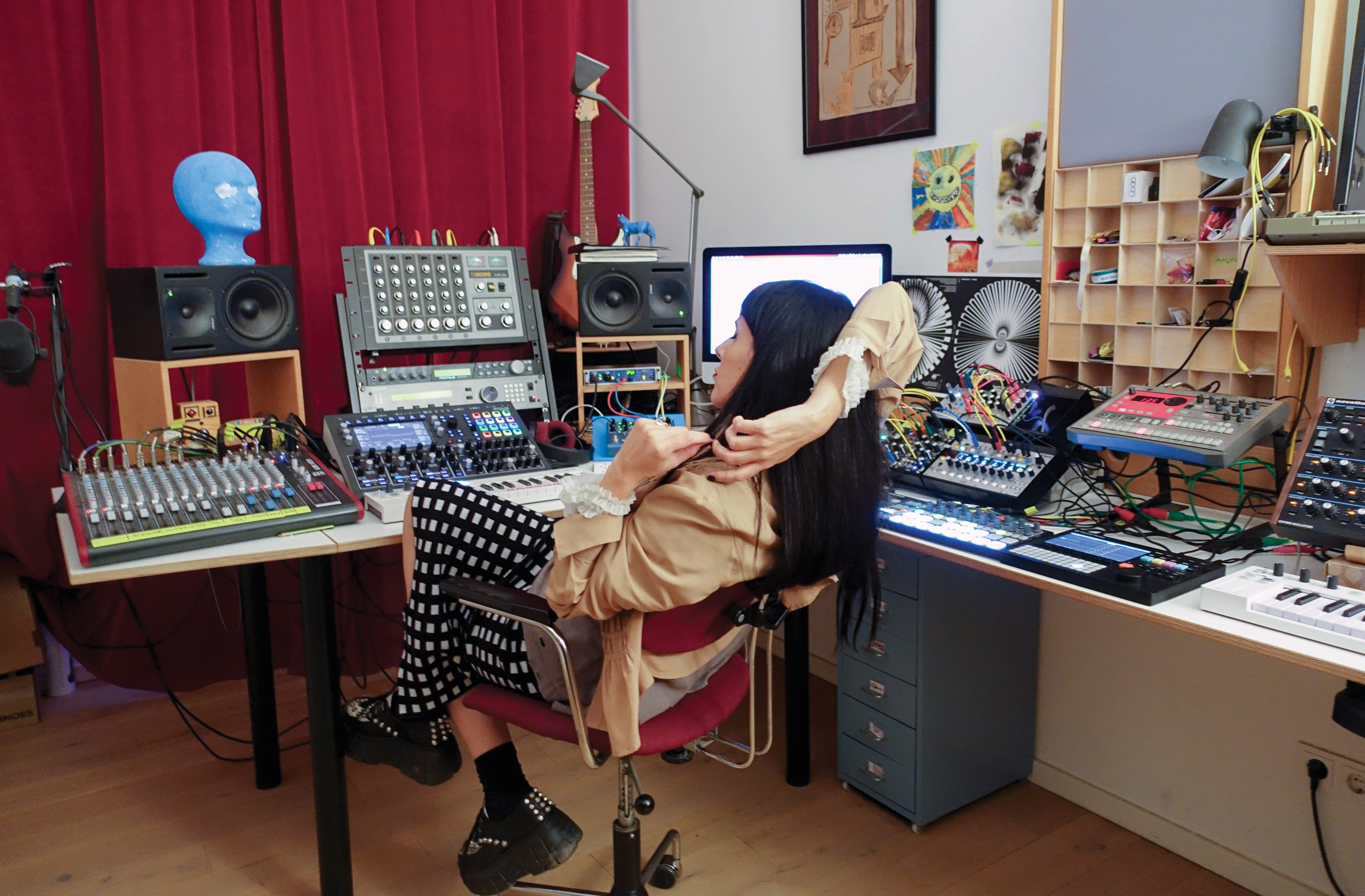Fantastic Twins on creating imaginary characters with vocal effects and the Eventide H3500: "The machine is basically endless, especially when it comes to working with vocals"
Based on her schizoid Fantastic Twins persona, Danny Turner delves deep into Julienne Dessagne’s eerie debut album, Two Is Not a Number

Since the creation of Fantastic Twins in 2013, electronic artist Julienne Dessagne has revelled in the abstract and literal narratives behind what she imaginatively refers to as her ‘brain children’.
Early releases fluctuated between deep techno and synth pop noir, culminating in Dessagne’s fantastically bizarre soundtrack LP Obakodomo (2017) – an icy concoction of Antarctic atmospheres, originally commissioned for a contemporary dance production for children.
Numerous experimental EPs have followed, including the Dada-inspired 2222022, reverse-engineered live experiment Lost In Germany and last year’s adrenaline-heavy, modular-based 46cm Hole In Her Cell.
Now, on what Dessagne considers to be her true debut album, Two Is Not a Number, the producer goes further in chronicling the entwined lives of her imaginary Fantastic Twins identity. Dark and twisted with unnerving processed vocals, it’s not for the fainthearted.
What role did computer games play in your early fascination with electronic music?
“I played a lot of video games as a kid and that really had an influence on my interest in this field. I started on an Atari ST and there were quite a lot of video game developers in France, some of which had fantastic soundtracks that I enjoyed playing along to. I have a big brother too, so video games would be all he’d order for Christmas or birthdays. What I found incredible is how the music was made with such limited technology, and it’s funny that with all the technology we have, now people are still trying to recreate that charismatic sound.”
Were the Fantastic Twins ever twins – meaning, two of you involved in the project?
Want all the hottest music and gear news, reviews, deals, features and more, direct to your inbox? Sign up here.
“I like to refer to it as my ‘brain children’. The idea is not that I have a twin, but an abstract concept that symbolises a lot of things for me. Having used that moniker for quite some time, you have to find ways to explore that as far as you can go, but I’ve found there are so many things that can fall under this concept.
I don’t think there is any value in repeating a formula so I try to start anew every time
“I can use the ‘twins’ in a literal way or a lot more abstract. I don’t know if you ever go on YouTube and watch totally stupid stuff, but on one of my late night adventures I found out that twins often speak at the same time, using the same words. It was quite disturbing to watch, but I liked the idea of layering vocals with unsynchronised timings to create a similar unison effect.”
You have changed your approach from one EP to the next. Is that tendency driven by your ever-changing ‘twins’ narrative or is it that you simply get bored of repeating yourself?
“It’s a combination of both things. Exploring the idea of the twins and forever creating more abstract interpretations of that concept has led me to approach sound in different ways, but what you said about getting bored is also true. I don’t think there is any value in repeating a formula so I try to start anew every time. My studio also has a big turnover of gear – I buy, test and use certain pieces of gear for a while before reselling them, although there are a few pieces that I never depart from.”

Diving into some of the other narratives behind your music, could you tell us about your soundtrack album Obakodomo and how it relates to contemporary dance?
“Obakodomo was a soundtrack that was originally created for a piece of contemporary dance for children and I had no intention of releasing it on vinyl until I played it to JD Twitch who runs Optimo Music. The script and story took place in Antarctica, so I defined the sound palette by using instruments that have an icy, cold tone to them.
Trying to represent an atmosphere or ecosystem in that way is something I try to do on every release
“Trying to represent an atmosphere or ecosystem in that way is something I try to do on every release, but Obakodomo was different to my latest album, Two Is Not a Number, which feels more like my true debut. The only link between them is that they’re based on imaginary fiction.”
For your EP titled 2222022, you asked people to listen to the music, analyse their experience and email you their thoughts. Did you get any responses?
“I did [laughs]. A few lost souls got in touch with some nice words, but it was all quite absurd and random. I didn’t expect to get any responses at all – it was just a tongue-in-cheek thing, but the phrasing for that EP was stolen from something I’d seen at a Dada exhibition by Duchamp and Frederick Kiesler who created something called the Twin-Touch-Test where people had to take part in some sort of surreal, absurdist experience and then report back on it.”
Your last album Two Is Not a Number seems to further this imaginary twins theme that we discussed earlier?
“The idea was to tell the story of these twins and their lives – their faiths, dreams and the little tragedies they come across – and try to create a sonic world for that. I see music as being a dialogue and wanted to use the context of twins, or my brain children, to have that dialogue while creating this sound environment.”
What sort of feelings are you trying to evoke within yourself and the listener?
“The album is very introspective and unlike my work in soundtrack I didn’t have any written scripts, so what I wanted to say was a blank canvas that I tried to fill with feelings of fear and claustrophobia. That affected how I treated the vocals and spatialisation of elements within the mix, and it’s also why the text and lyrics are very simple – it’s not about what I say, it’s about how the sound of the vocals translates those feelings.
I wanted to export this emotional spectrum and how I used vocal placements within the stereo field had a massive role to play in that
“For example, is the sound coming from your gut, is it a whisper, a thought represented by a loop in your head, or are you talking to yourself? I wanted to export this emotional spectrum and how I used vocal placements within the stereo field had a massive role to play in that.”
Do you see the dark, abstract tone of the music akin to a horror film soundtrack?
“I like exaggerating things within an imaginary, fictional world. The emotions are predominantly dark and I want them to feel as real as possible, which is something that I inherited from making soundtracks for children and discovering how you can trigger their imagination without falling into something that is a caricature or too obvious. I like to play a lot with fear or things that are slightly uncomfortable because that’s when the imagination starts triggering, and I have a big affection for reverbs and delays that help to create that sense of space.”

Psychological space or some sort of otherworldly space?
“Outer space is something infinite, which is itself fascinating but also frightening and electronic music offers so much in that direction. I don’t know about you, but when I was a child I was also scared of the dark and that triggered a lot of images in my head that were quite fabulous. The music is dark, but it’s mostly ambiguous and I love to explore that ambiguity. I’ve never managed to make happy music – even if I had to do it for a TV ad I would struggle [laughs].”
The track I Was First is suitably creepy – especially your use of vocal samples. Are they yours or based on samples you sourced from various places?
“They are all my vocals. I played a lot with pitch variation and tons of effects using my Eventide H3000, which is great for doing that. In general though, the vocals on the album are not mine.
My Eventide H3000, which is now an H3500, is the main piece of gear in my studio that I always come back to
“I have a library where I collect all of my recording experiments and take lots of vocals from film recordings, YouTube documentaries or even recordings of my son playing in the living room. I might extract a tiny part of dialogue or a sentence that is very banal or stupid, but once I take it out of context and put it into my eerie musical environment, the words take on a whole other dimension.”
We’ve read elsewhere that you’re a big fan of Eventide gear…
“My Eventide H3000, which is now an H3500, is the main piece of gear in my studio that I always come back to. The machine is basically endless, especially when it comes to working with vocals. The voice is an amazing medium because when you send it through a chain of effects it never reacts the same way. The Eventide also has infinite possibilities – it’s just a fascinating piece of gear that brings consistency to all of my vocal treatments.”

The track Silver Moon Dial is slightly different in that the vocals are used tonally…
“The title is actually inspired from the parameters on my Eventide’s dials. I was playing around with the looping function and sampling my vocals using sequencers and sending them through various effects. After doing that a few times, you lose the quality of the vocal and it starts to become more like a synth lead or tone.”
We read that you used a lot of Roland gear on this record?
“I would have loved to have limited myself that way, but it didn’t happen, mostly due to my addiction to using different gear. The album took a long time to make and my studio changed a lot throughout the process, so there was some Roland gear used but I also used a lot of modular from a Eurorack system I’ve been building. The last part of the recording process included some additional production and mixing with Superpitcher at his studio in Paris.
“He has some very nice effects units from the ’60s and ’70s, so we’d send stems that were already heavily processed and rerecord them through a Dynacord Echocord. It was a challenge to make the album sound homogenous rather than a collection of EPs, but I had wanted to keep to the romantic idea of having an LP that you can listen to from beginning to end, with broad wide spaces that are gluing the tracks together.”

What’s your approach to using Eurorack and how would you recommend people approach that world?
“I started to get more in-depth with modular during the pandemic and found it disorienting at first and overwhelmed by what was on the market. It comes back to my passion for transforming and processing, so while I use it as a source, the modules I prefer are typically effects modules.
“I used the ALM Squid Salmple module quite a lot on drums, vocals and tiny parts of field recordings to use as textures or sound effects. I’d record them, sample them, import them into the Squid and then modulate and sequence the sounds with other modules.
I’m not comfortable using a DAW for sequencing and prefer to use external hardware sequencers
“It’s hard to recommend what people should use because I don’t feel I’ve experimented with modular enough, but I adore Make Noise. As a company, their modules are complex and have their own ecosystem, so once you understand one, you understand them all. It really depends on what your soft spot is when it comes to sound, and mine is extreme processing.”
Is everything you use integrated with software or do you see a clear separation there?
“I’m not comfortable using a DAW for sequencing and prefer to use external hardware sequencers. The software I do use is, again, mostly for processing. Universal Audio plugins are my go-to VSTs and the Arturia V Collection is amazing. I also use Native Instruments’ Guitar Rig, iZotope and Spitfire sample libraries, but I do tend to get distracted quite easily when looking at a screen.
“Ableton Live is an amazing tool, but you tend to make decisions according to what you see and not what you hear, so I struggle to spend too much time using software. If I can’t find a sound from a VST, I’ll MIDI map a controller to a piece of hardware and take a more hands-on approach.”
Your Lost in Germany EP was interesting in as much as you reverse-engineered it by editing live tracks into finished form. Can you tell us more about that? Do you feel that you were ultimately able to successfully capture the energy that people experience at your live performances in a studio environment?
“The bridge between studio and live is always very challenging because the way I work within both is very different. With a vinyl release or something intended for home listening, I’m going to explore the stereo field a lot more, but that level of detailed sound doesn’t always translate well in a club or festival environment.
“In the case of Lost in Germany, I was working with live tracks that were very simple and had a direct impact on the listener, yet when I listened to those same tracks in the studio it was a completely different atmosphere and environment. That necessitated having to add levels of detail to tracks that were used to having a raw, primitive energy to them and it was hard to make them sound more interesting without losing that.”

Did recreating the tracks necessitate you using the same gear that you’d initially used live?
“I tried to stick with what I used for the live performance but it goes both ways because on stage I’m also using audio clips that have been processed and recorded in the studio, and those clips are coming from so many different sources that I can’t replicate that on stage or carry all the same machines around with me. The only exception was to use something like the Eventide H3000, which works well in both environments because it’s transportable.”
Once you’ve finished a release, you’re known for diverging away from the source material live. How do you approach that?
“I rarely play exactly what’s on the record. The limitations of the sound system I’m performing on affects my decision making, but my intention is for the music to always provoke an emotion. How you do that on stage is different to a record because it has to be shared with people and I have to sing.
Sometimes I take risks by letting sounds develop until they start getting quite intense
“There’s no point using live vocals if you don’t perform or embody them, but not everything can be played in real-time. Sometimes I take risks by letting sounds develop until they start getting quite intense. I have stage fear, but most people who see me would not detect that.”
Do you have to embrace the fear?
“You have to find ways to work with fear. If you’re always super-certain of yourself I’m not sure it’s all that interesting for people to watch, musically or artistically. Putting yourself at risk and going places where you don’t know what’s going to happen is scary but also extremely rewarding. It’s where the magic happens!”
Fantastic Twins' new album Two Is Not a Number is out now on House of Slessor.

